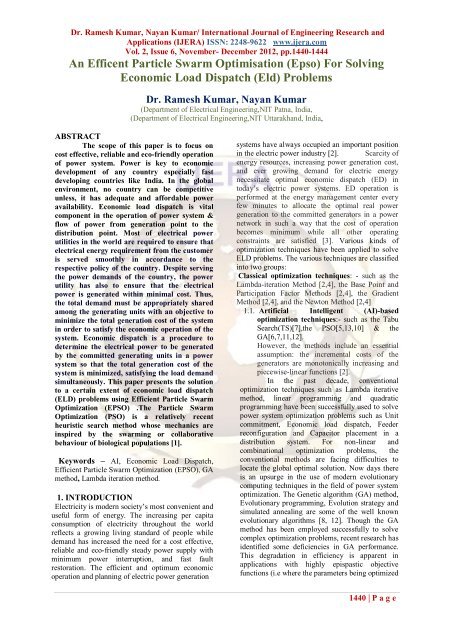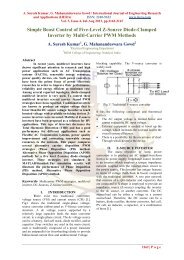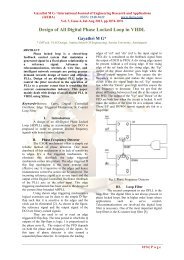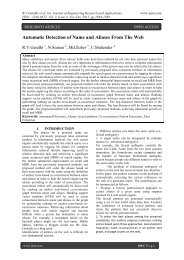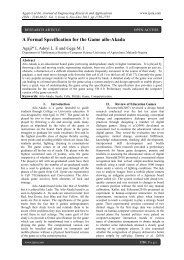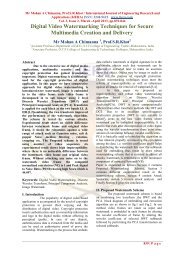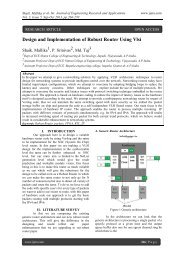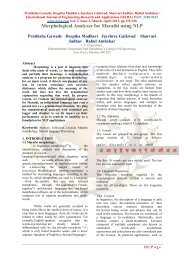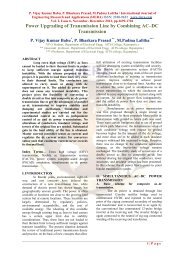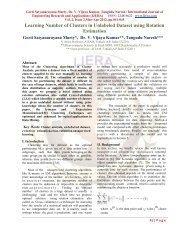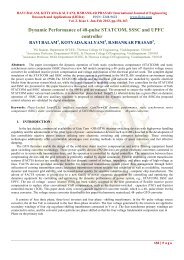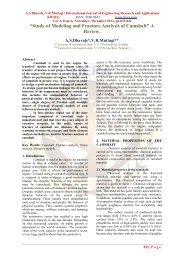Dr. Ramesh Kumar, Nayan Kumar - International Journal of ...
Dr. Ramesh Kumar, Nayan Kumar - International Journal of ...
Dr. Ramesh Kumar, Nayan Kumar - International Journal of ...
Create successful ePaper yourself
Turn your PDF publications into a flip-book with our unique Google optimized e-Paper software.
<strong>Dr</strong>. <strong>Ramesh</strong> <strong>Kumar</strong>, <strong>Nayan</strong> <strong>Kumar</strong>/ <strong>International</strong> <strong>Journal</strong> <strong>of</strong> Engineering Research and<br />
Applications (IJERA) ISSN: 2248-9622 www.ijera.com<br />
Vol. 2, Issue 6, November- December 2012, pp.1440-1444<br />
An Efficent Particle Swarm Optimisation (Epso) For Solving<br />
Economic Load Dispatch (Eld) Problems<br />
<strong>Dr</strong>. <strong>Ramesh</strong> <strong>Kumar</strong>, <strong>Nayan</strong> <strong>Kumar</strong><br />
(Department <strong>of</strong> Electrical Engineering,NIT Patna, India,<br />
(Department <strong>of</strong> Electrical Engineering,NIT Uttarakhand, India,<br />
ABSTRACT<br />
The scope <strong>of</strong> this paper is to focus on<br />
cost effective, reliable and eco-friendly operation<br />
<strong>of</strong> power system. Power is key to economic<br />
development <strong>of</strong> any country especially fast<br />
developing countries like India. In the global<br />
environment, no country can be competitive<br />
unless, it has adequate and affordable power<br />
availability. Economic load dispatch is vital<br />
component in the operation <strong>of</strong> power system &<br />
flow <strong>of</strong> power from generation point to the<br />
distribution point. Most <strong>of</strong> electrical power<br />
utilities in the world are required to ensure that<br />
electrical energy requirement from the customer<br />
is served smoothly in accordance to the<br />
respective policy <strong>of</strong> the country. Despite serving<br />
the power demands <strong>of</strong> the country, the power<br />
utility has also to ensure that the electrical<br />
power is generated within minimal cost. Thus,<br />
the total demand must be appropriately shared<br />
among the generating units with an objective to<br />
minimize the total generation cost <strong>of</strong> the system<br />
in order to satisfy the economic operation <strong>of</strong> the<br />
system. Economic dispatch is a procedure to<br />
determine the electrical power to be generated<br />
by the committed generating units in a power<br />
system so that the total generation cost <strong>of</strong> the<br />
system is minimized, satisfying the load demand<br />
simultaneously. This paper presents the solution<br />
to a certain extent <strong>of</strong> economic load dispatch<br />
(ELD) problems using Efficient Particle Swarm<br />
Optimization (EPSO) .The Particle Swarm<br />
Optimization (PSO) is a relatively recent<br />
heuristic search method whose mechanics are<br />
inspired by the swarming or collaborative<br />
behaviour <strong>of</strong> biological populations [1].<br />
Keywords – AI, Economic Load Dispatch,<br />
Efficient Particle Swarm Optimization (EPSO), GA<br />
method, Lambda iteration method.<br />
1. INTRODUCTION<br />
Electricity is modern society‟s most convenient and<br />
useful form <strong>of</strong> energy. The increasing per capita<br />
consumption <strong>of</strong> electricity throughout the world<br />
reflects a growing living standard <strong>of</strong> people while<br />
demand has increased the need for a cost effective,<br />
reliable and eco-friendly steady power supply with<br />
minimum power interruption, and fast fault<br />
restoration. The efficient and optimum economic<br />
operation and planning <strong>of</strong> electric power generation<br />
systems have always occupied an important position<br />
in the electric power industry [2]. Scarcity <strong>of</strong><br />
energy resources, increasing power generation cost,<br />
and ever growing demand for electric energy<br />
necessitate optimal economic dispatch (ED) in<br />
today‟s electric power systems. ED operation is<br />
performed at the energy management center every<br />
few minutes to allocate the optimal real power<br />
generation to the committed generators in a power<br />
network in such a way that the cost <strong>of</strong> operation<br />
becomes minimum while all other operating<br />
constraints are satisfied [3]. Various kinds <strong>of</strong><br />
optimization techniques have been applied to solve<br />
ELD problems. The various techniques are classified<br />
into two groups:<br />
Classical optimization techniques: - such as the<br />
Lambda-iteration Method [2,4], the Base Point and<br />
Participation Factor Methods [2,4], the Gradient<br />
Method [2,4], and the Newton Method [2,4]<br />
1.1. Artificial Intelligent (AI)-based<br />
optimization techniques:- such as the Tabu<br />
Search(TS)[7],the PSO[5,13,10] & the<br />
GA[6,7,11,12].<br />
However, the methods include an essential<br />
assumption: the incremental costs <strong>of</strong> the<br />
generators are monotonically increasing and<br />
piecewise-linear functions [2].<br />
In the past decade, conventional<br />
optimization techniques such as Lambda iterative<br />
method, linear programming and quadratic<br />
programming have been successfully used to solve<br />
power system optimization problems such as Unit<br />
commitment, Economic load dispatch, Feeder<br />
reconfiguration and Capacitor placement in a<br />
distribution system. For non-linear and<br />
combinational optimization problems, the<br />
conventional methods are facing difficulties to<br />
locate the global optimal solution. Now days there<br />
is an upsurge in the use <strong>of</strong> modern evolutionary<br />
computing techniques in the field <strong>of</strong> power system<br />
optimization. The Genetic algorithm (GA) method,<br />
Evolutionary programming, Evolution strategy and<br />
simulated annealing are some <strong>of</strong> the well known<br />
evolutionary algorithms [8, 12]. Though the GA<br />
method has been employed successfully to solve<br />
complex optimization problems, recent research has<br />
identified some deficiencies in GA performance.<br />
This degradation in efficiency is apparent in<br />
applications with highly epispastic objective<br />
functions (i.e where the parameters being optimized<br />
1440 | P a g e
<strong>Dr</strong>. <strong>Ramesh</strong> <strong>Kumar</strong>, <strong>Nayan</strong> <strong>Kumar</strong>/ <strong>International</strong> <strong>Journal</strong> <strong>of</strong> Engineering Research and<br />
Applications (IJERA) ISSN: 2248-9622 www.ijera.com<br />
Vol. 2, Issue 6, November- December 2012, pp.1440-1444<br />
are highly correlated). The crossover and mutation<br />
operations cannot ensure better fitness <strong>of</strong> <strong>of</strong>fspring<br />
because chromosomes in the population have<br />
similar structures and their average fitness is high<br />
towards the end <strong>of</strong> the evolutionary process.<br />
Moreover, the premature convergence <strong>of</strong> GA<br />
degrades its performance and reduces its search<br />
capability that leads to a higher probability for<br />
obtaining a local optimum [9].<br />
One <strong>of</strong> the evolutionary algorithms that<br />
have shown great potential and good perspective<br />
for the solution <strong>of</strong> various optimization problems is<br />
EPSO.<br />
The EPSO technique can generate highquality<br />
solutions within shorter calculation time and<br />
stable convergence characteristics than other<br />
stochastic methods [5].<br />
This paper proposes the application <strong>of</strong><br />
EPSO method for solving the economic load<br />
dispatch problems <strong>of</strong> three unit power system.<br />
2. MATHEMATICAL MODEL OF THE<br />
ECONOMIC DIAPATCH PROBLEM<br />
2.1 Basic Concept <strong>of</strong> Economic Dispatch<br />
Formulation<br />
The Economic Load Dispatch (ELD) is<br />
used to find the optimal combination <strong>of</strong> generators<br />
output so as to minimize the total fuel cost<br />
satisfying several constraints. The problem is to<br />
minimize the total fuel cost which is formulated as<br />
the sum <strong>of</strong> the cost function <strong>of</strong> each generator,<br />
which must satisfy the objective function:<br />
Mathematically it can be represented as [2]<br />
Minimize: ………………………..1<br />
Where ………….<br />
2<br />
1) Real Power Balance Equation<br />
The power balance equation,<br />
………………………………3<br />
The total Transmission loss,<br />
………………………………….4<br />
2) Unit Operating Limits<br />
There is a limit on the amount <strong>of</strong> power<br />
which a unit can deliver. The power output <strong>of</strong> any<br />
unit should neither exceed its rating nor it should<br />
be below that is necessary for stable operation.<br />
Generation output <strong>of</strong> each unit should lie between<br />
maximum and minimum limits. The corresponding<br />
inequality constraints for each generator are;<br />
3. EFFICENT PARTICLE SWARM<br />
OPTIMIZATION(EPSO)<br />
Particle swarm optimization (PSO) is a<br />
population based stochastic optimization technique<br />
developed by <strong>Dr</strong>. Ebert and <strong>Dr</strong>. Kennedy in 1995,<br />
inspired by social behaviour <strong>of</strong> bird flocking or fish<br />
schooling [5]. Suppose the following scenario: a<br />
group <strong>of</strong> birds are randomly searching food in an<br />
area. There is only one piece <strong>of</strong> food in the area<br />
being searched. All the birds do not know where<br />
the food is. But they know how far the food is in<br />
each iteration, so what's the best strategy to find the<br />
food. The effective one is to follow the bird, which<br />
is nearest to the food. PSO learned from the<br />
scenario and used it to solve the optimization<br />
problems. In PSO, each single solution is a "bird"<br />
in the search space. We call it "particle". All<br />
particles have fitness values, which are evaluated<br />
by the fitness function to be optimized, and have<br />
velocities, which direct the flying <strong>of</strong> the particles.<br />
The particles fly through the problem space by<br />
following the current optimum particles.<br />
Let x and v denote a particle co-ordinate<br />
and its corresponding flight speed in a search space<br />
respectively. Therefore, each i th particle is treated<br />
as a volume less particle, represented as xi= (xi1, xi2<br />
…xid) in the d-dimensional space. The best<br />
previous position <strong>of</strong> the ith particle is recorded and<br />
represented as pbesti=(pbesti1, pbesti2,…….. pbestid).The<br />
index <strong>of</strong> the best particle among all the particles is<br />
treated as global best particle and is represented as<br />
gbestd. The rate <strong>of</strong> velocity for particle „i‟ is<br />
represented as vi= (vi1, vi2……...vid).The modified<br />
velocity and position <strong>of</strong> each particle can be<br />
calculated using the current velocity and the<br />
distance from pbestid to gbestd as shown in the<br />
following<br />
formulas,<br />
………………5<br />
……………………6<br />
In the above equation,<br />
C1 is called self-confidence range; (1.5, 2)<br />
C2 is called swarm range; (2, 2.5)<br />
Rand ( )*(g best d-Pgid (t) ) is called swarm influence<br />
vi (t) is the velocity <strong>of</strong> i th particle at iteration„t‟ must<br />
lie in the range Vd min ≤ vid (t) ≤ Vd max<br />
Vd max was <strong>of</strong>ten set at 10-20% <strong>of</strong> the dynamic range<br />
on each dimension<br />
In general, the inertia weight ω is set according to<br />
the following equation:<br />
………….7<br />
Where,<br />
ω - Inertia weight factor<br />
ωmin - maximum value <strong>of</strong> weighting factor<br />
ωmax - minimum value <strong>of</strong> weighting factor<br />
itermax - maximum number <strong>of</strong> iterations<br />
iter - current number <strong>of</strong> iteration<br />
The following property <strong>of</strong> EPSO explains its<br />
advantages:<br />
1441 | P a g e
<strong>Dr</strong>. <strong>Ramesh</strong> <strong>Kumar</strong>, <strong>Nayan</strong> <strong>Kumar</strong>/ <strong>International</strong> <strong>Journal</strong> <strong>of</strong> Engineering Research and<br />
Applications (IJERA) ISSN: 2248-9622 www.ijera.com<br />
Vol. 2, Issue 6, November- December 2012, pp.1440-1444<br />
• Generally good at finding acceptable solutions to<br />
a problem reasonably quickly<br />
• Free <strong>of</strong> mathematical derivatives<br />
• No gradient information is required<br />
• Free <strong>of</strong> restrictions on the structure <strong>of</strong> the<br />
evaluation function<br />
• Fairly simple to develop<br />
• Do not require complex mathematics to execute<br />
• Able to vary not only the values, but also the<br />
structure <strong>of</strong> the solution<br />
• Get a good set <strong>of</strong> answers, as opposed to a single<br />
optimal answer<br />
• Make no assumptions about the problem space<br />
• Blind without the fitness function. The fitness<br />
function drives the population toward better<br />
• Solutions and is the most important part <strong>of</strong> the<br />
algorithm.<br />
• Not guaranteed to find the global optimum<br />
solutions<br />
• Probability and randomness are essential parts <strong>of</strong><br />
GA<br />
• Can by hybridized with conventional optimization<br />
methods<br />
• Potential for executing many potential solutions in<br />
parallel<br />
• Deals with large number <strong>of</strong> variables<br />
• Provides a list <strong>of</strong> optimum variables<br />
4. IMPLEMENTATION OF THE<br />
EFFICENT PARTICLE SWARM<br />
OPTIMIZATION ALGORITHM FOR<br />
ECONOMIC DISPATCH PROBLEM<br />
The EPSO algorithm was utilized mainly<br />
to determine the optimal allocation <strong>of</strong> power among<br />
the units, which were scheduled to operate at the<br />
specific period, thus minimizing the total<br />
generation cost. Any optimization process is<br />
applied to the ELD problem considering some<br />
constraints.<br />
In this work two different constraints are<br />
considered. Among them the equality constraint,<br />
summation <strong>of</strong> all the generating power must be<br />
equal to the load demand and the inequality<br />
constraint, the powers generated must be within the<br />
limit <strong>of</strong> maximum and minimum active power <strong>of</strong><br />
each unit.<br />
In this work economic load dispatch<br />
problem considered, can be classified in two<br />
different ways.<br />
1. Economic load dispatch without considering the<br />
transmission line losses<br />
2. Economic load dispatch considering the<br />
transmission line losses.<br />
RESULT ANALYSIS AND DISCUSSION<br />
Three unit Power system results <strong>of</strong> EPSO<br />
and Genetic Algorithm (GA) are compared with the<br />
Lambda Iteration method. In the first case<br />
transmission losses are neglected.<br />
The cost characteristics <strong>of</strong> the three units<br />
The unit operating ranges are:<br />
100<br />
For minimum cost optimum solution:<br />
.<br />
.<br />
.<br />
For the system loads <strong>of</strong> PD= 450MW, 858MW,<br />
700MW, 800MW, 900MW<br />
EPSO Method Parameters:<br />
c1 = c2 =2.01<br />
Population size = 10<br />
The maximum value <strong>of</strong> w is chosen 0.9 and<br />
minimum value is chosen 0.4<br />
GA Method Parameters<br />
Chromosomes size =10<br />
string length =10<br />
Crossover operation =0.8<br />
Cost in Rs/Hr<br />
Comparison <strong>of</strong> cost in three<br />
different methods without<br />
loss<br />
10000<br />
9000<br />
8000<br />
7000<br />
6000<br />
5000<br />
4000<br />
3000<br />
2000<br />
1000<br />
0<br />
Lambda<br />
iteration<br />
450<br />
MW<br />
585<br />
MW<br />
700<br />
MW<br />
800<br />
MW<br />
900<br />
MW<br />
4650. 5818. 6834. 7738. 8647.<br />
EPSO 4652. 5821. 6838. 7738. 8653.<br />
GA 4652. 5821. 6838. 7738. 8653.<br />
Table 1: Comparison <strong>of</strong> cost in three different<br />
methods without loss<br />
1442 | P a g e
Cost in Rs/Hr<br />
<strong>Dr</strong>. <strong>Ramesh</strong> <strong>Kumar</strong>, <strong>Nayan</strong> <strong>Kumar</strong>/ <strong>International</strong> <strong>Journal</strong> <strong>of</strong> Engineering Research and<br />
Applications (IJERA) ISSN: 2248-9622 www.ijera.com<br />
450<br />
M<br />
W<br />
Vol. 2, Issue 6, November- December 2012, pp.1440-1444<br />
Comparison <strong>of</strong> Cost between<br />
three methods with losses<br />
10000<br />
9000<br />
8000<br />
7000<br />
6000<br />
5000<br />
4000<br />
3000<br />
2000<br />
1000<br />
0<br />
Lambda<br />
iteration<br />
585<br />
M<br />
W<br />
700<br />
M<br />
W<br />
800<br />
M<br />
W<br />
900<br />
M<br />
W<br />
4665 5845 6872 7783 8712<br />
EPSO 4664 5842 6869 7779 8706<br />
GA 4664 5842 6869 7779 8706<br />
FIG 2: Comparison <strong>of</strong> cost in three different<br />
methods with loss<br />
5. CONCLUSION<br />
Lambda-iteration Method used for<br />
Economic Load Dispatch is better but the problem<br />
converges when the Lambda value is selected<br />
within the feasible range. The cost characteristic<br />
takes much number <strong>of</strong> iterations to converge. In<br />
EPSO and GA method for ELD problem, the cost<br />
characteristic converges in less number <strong>of</strong><br />
iterations. The EPSO method was successfully<br />
employed to solve the ELD problem with all the<br />
constraints. The EPSO algorithm has been<br />
demonstrated to have superior features including<br />
high quality solution, stable convergence<br />
characteristics, and less computation time. Many<br />
non-linear characteristics <strong>of</strong> the generators can be<br />
handled efficiently by the proposed method. The<br />
comparison <strong>of</strong> results for the test cases clearly<br />
shows that the proposed method was indeed<br />
capable for obtaining higher quality solution<br />
efficiently for ELD problems.<br />
LIST OF ABBREVIATIONS AND SYMBOLS<br />
Abbreviations<br />
ED Economic dispatch<br />
GA Genetic algorithm<br />
PSO Particle swarm optimization<br />
ELD Economic load dispatch<br />
EPSO Efficient Particle swarm optimization<br />
TS Tabu search<br />
Symbols<br />
Ft - Total fuel cost<br />
N - Number <strong>of</strong> online generators committed to the<br />
operating system<br />
Pi - Power output <strong>of</strong> i th generator.<br />
Fi(Pi) - Fuel cost characteristics <strong>of</strong> the i th generator<br />
PD -Total power demand<br />
PL - Total transmission loss<br />
Bmn - Co-efficient <strong>of</strong> Transmission loss formula.<br />
Pi max - Maximum generation capacity <strong>of</strong> the i th<br />
generator<br />
Pimin - Minimum generation capacity <strong>of</strong> the i th<br />
generator.<br />
n - Number <strong>of</strong> particles in a group<br />
m - Number <strong>of</strong> members in a particle<br />
t - Pointer <strong>of</strong> iterations (generations)<br />
ω - Inertia weight factor<br />
C1, C2- Acceleration constant<br />
rand(), rand() - Uniform random value in the range<br />
[0,1]<br />
Vid (t) - velocity <strong>of</strong> particle i at iteration„t‟,<br />
Vd min ≤ Vid (t) ≤ Vd max<br />
Xid (t) - current position <strong>of</strong> particle i at iteration„t‟<br />
Ai, Bi, Ci - Fuel cost coefficients<br />
REFERENCES<br />
[1]. Rania Hassan, Babak Cohanim and Olivier<br />
de Weck “A copmarision <strong>of</strong> particle<br />
swarm optimization and genetic<br />
algorithm” American Institute <strong>of</strong><br />
Aeronautics and Astronautics, 2004<br />
[2] Wood AJ, B.F.Wollenberg Power<br />
Generation Operation and Control. John<br />
Wiley & Sons: New York, 1984.<br />
[3] Liu D, Cai Y. Taguchi method for solving<br />
the economic dispatch problem with<br />
nonsmooth cost functions. IEEE<br />
Transactions on Power System 2005<br />
[4] D.P.Kothari and J.S.Dhillon, Power<br />
system optimization (2 nd printing)<br />
prentice- hall <strong>of</strong> India, NEW<br />
DELHI(2006)<br />
[5] Maurice Clerc, Particle swarm<br />
optimization. ISET Ltd.,Great Britain and<br />
the United States, 2006.<br />
[6] D. C.Walters and G. B. Sheble, “Genetic<br />
algorithm solution <strong>of</strong> economic dispatch<br />
with valve point loading”, IEEE Trans. on<br />
Power Systems, vol.10, No.8, pp. 1325-<br />
1332, Aug. 1993.<br />
[7] M. Sudhakaran, <strong>Dr</strong> S M R Slochanal,<br />
“Integrating Genetic Algorithms and Tabu<br />
Search for Emission and Economic<br />
Dispatch Problems”, IE (I) <strong>Journal</strong> –EL,<br />
vol 86, pp.39-43, June 2005.<br />
[8] R. C. Eberhart and Y. Shi, “Comparison<br />
between genetic algorithms and particle<br />
swarm optimization,” Proceedings <strong>of</strong><br />
IEEE Int. Conference on Evolutionary<br />
Computation, pp.611–616, May 1998.<br />
[9] Nidul Sinha, Chakrabarti.R, and<br />
Chattopadhyay.P.K, “Fast Evolutionary<br />
Computing Techniques for Short-Term<br />
Hydrothermal Scheduling”,IEEE Trans.<br />
on Power Systems, vol.18, No.1, pp. 214-<br />
220, February 2003.<br />
1443 | P a g e
<strong>Dr</strong>. <strong>Ramesh</strong> <strong>Kumar</strong>, <strong>Nayan</strong> <strong>Kumar</strong>/ <strong>International</strong> <strong>Journal</strong> <strong>of</strong> Engineering Research and<br />
Applications (IJERA) ISSN: 2248-9622 www.ijera.com<br />
Vol. 2, Issue 6, November- December 2012, pp.1440-1444<br />
[10] Kennedy J, Eberhart R. Particle swarm<br />
optimization. IEEE <strong>International</strong><br />
Conference on Neural Networks, Vol. 4,<br />
1995; 1942–1948.<br />
[11] Saddukaran M.R.(2004)”Applications <strong>of</strong><br />
refined Genetic algorithm to combined<br />
Economic and Emission dispatch”, <strong>Journal</strong><br />
institution <strong>of</strong> engineers(India), Vol<br />
85,pp.115-119.<br />
[12] Angeline, P. J. 1995. Evolution revolution:<br />
An introduction to the special track on<br />
genetic and evolutionary programming.<br />
IEEE Exp. Intell. Syst. Appl. 10:610.<br />
[13] Rohit <strong>Kumar</strong> Pancholi, K.S.Swarup,<br />
Particle Swarm Optimization For Security<br />
Constrained Economic Dispatch,<br />
Proceedings <strong>of</strong> <strong>International</strong> Conference<br />
on, Intelligent Sensing and Information<br />
Processing, 2004.<br />
Author’s Pr<strong>of</strong>ile<br />
1 <strong>Dr</strong>. <strong>Ramesh</strong> kumar is Associate Pr<strong>of</strong>essor in<br />
Department <strong>of</strong> Electrical Engg. at National Institute<br />
<strong>of</strong> Technology Patna.<br />
2 <strong>Nayan</strong> kumar is Assistant Pr<strong>of</strong>essor in<br />
Department <strong>of</strong> Electrical Engg. at National<br />
Institute <strong>of</strong> Technology Uttarakhand.<br />
1444 | P a g e


